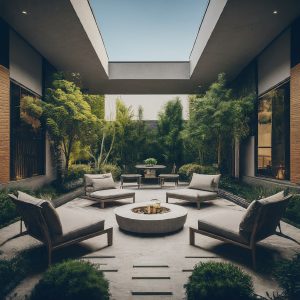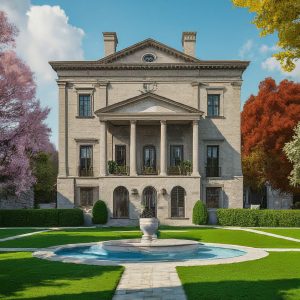Ever wished your landscape could be a showstopper, no matter the season? Imagine vibrant spring blooms transitioning to lush summer foliage, followed by a breathtaking autumnal display, and finally, a captivating winter scene. Achieving this year-round landscape design isn’t just a dream – it’s entirely possible with the power of 3D rendering.
Traditional landscape planning often leaves you guessing how your vision will translate into reality. But 3D rendering revolutionizes the process, allowing you to visualize and fine-tune your landscape design before the first plant is even purchased. This innovative technology empowers homeowners, landscapers, and designers to create breathtaking outdoor spaces that evolve with the seasons, providing a captivating experience throughout the year.
In this guide, we’ll delve into how 3D rendering transforms the landscape design process and show you how to plan a garden that thrives in spring, summer, fall, and winter. Get ready to discover the secrets of crafting a captivating outdoor oasis that delights year-round.
The Power of 3D Rendering in Landscape Design
3D rendering isn’t just for video games and movies – it’s a game-changer in the world of landscape design. Through specialized software, your landscape vision is transformed into photorealistic 3D models, complete with accurate lighting, textures, and plant life. This immersive visualization lets you virtually walk through your future garden, exploring every angle and detail as if it were already built.
Key Benefits of 3D Rendering:
- Visualization: Gone are the days of deciphering complex blueprints. With 3D rendering, you see exactly how your landscape will look, fostering a clear understanding of the design intent.
- Experimentation: 3D rendering empowers you to play with different plant combinations, hardscape materials, and layout options, all risk-free. This flexibility ensures you achieve the perfect aesthetic and functional balance before breaking ground.
- Cost Savings: 3D rendering helps avoid costly mistakes by identifying potential design flaws or conflicts early on. This saves both time and money during construction.
- Client Communication: For landscape designers, 3D rendering is a powerful communication tool. Clients can easily grasp the design concept and provide feedback, ensuring the final result meets their expectations.
Case Studies: Visualizing Success
- [Case Study 1]: A modern courtyard transformed with 3D rendering, highlighting how the technology helped maximize space and create a serene retreat.
- [Case Study 2]: A large estate revitalized with year-round blooms and foliage, showcasing how 3D rendering was used to plan for every season.
Planning for Each Season with 3D Rendering
Spring:
As winter fades, 3D rendering helps you envision the explosion of colors that spring brings. Select vibrant flowering trees like dogwoods or magnolias, and visualize their blooms against a backdrop of lush green foliage. Experiment with combinations of tulips, daffodils, and hyacinths to create a tapestry of hues.
Summer:
For the warmer months, 3D rendering aids in optimizing shade and outdoor living areas. Visualize the placement of shade trees like maples or oaks, and determine the ideal location for patios, pergolas, or pools. With 3D rendering, you can ensure that your summer landscape is both functional and inviting.
Autumn:
As the leaves change, 3D rendering allows you to play with warm autumnal colors and textures. Visualize the fiery reds and oranges of Japanese maples or the golden yellows of ginkgo trees. Incorporate ornamental grasses and late-blooming perennials like asters and mums for continued interest.
Winter:
Even in the dormant months, your landscape can remain captivating. Use 3D rendering to visualize evergreen shrubs and trees like hollies or boxwoods, which provide structure and interest. Explore different lighting options to create a warm and inviting atmosphere, and experiment with hardscape features like stone walls or pathways to add visual appeal. 3D rendering can even simulate snow cover, giving you a glimpse of your winter wonderland.
Microclimates: Unveiling Your Property’s Unique Conditions
Every landscape has its own microclimates – distinct areas with varying sunlight, shade, wind exposure, and soil conditions. These subtle variations can significantly impact plant health and overall aesthetic appeal. 3D rendering empowers you to analyze and account for these microclimates during the design process.
For instance, a south-facing slope may receive intense sun, making it ideal for drought-tolerant succulents and Mediterranean herbs. Conversely, a north-facing corner tucked behind a building might be better suited for shade-loving ferns and hostas.
With 3D rendering, you can virtually explore your property’s microclimates, visualizing how different plant species would thrive in each location. This allows you to tailor your plant choices precisely, ensuring a landscape that flourishes throughout the year.
Maintenance: Planning for Long-Term Beauty
A breathtaking landscape is not just about aesthetics; it’s also about practicality. During the design phase, consider the ongoing maintenance required to keep your garden looking its best. 3D rendering helps you anticipate these needs and create a design that’s both visually stunning and easy to care for.
For example, if you have limited time for upkeep, opt for low-maintenance plants that don’t require frequent pruning or watering. If you prefer a lush, manicured look, factor in the resources needed for regular mowing, fertilizing, and pest control. 3D rendering allows you to experiment with different plant combinations and layouts to achieve a balance between beauty and practicality.
Sustainability: Designing with the Environment in Mind
Creating a sustainable landscape is more important than ever. Eco-friendly practices like water conservation, soil health, and biodiversity preservation are essential for the long-term well-being of your garden and the environment. 3D rendering can play a pivotal role in integrating these principles into your design.
For instance, you can use 3D rendering to visualize the placement of rain gardens or bioswales to capture and filter stormwater runoff. You can experiment with drought-tolerant plant species and strategically place them to minimize irrigation needs. By incorporating sustainable practices from the outset, you can create a beautiful landscape that’s also environmentally responsible.
Conclusion: Your Dream Landscape, Unveiled Through 3D Rendering
As we’ve explored, 3D rendering is a powerful tool that revolutionizes the way we plan, design, and experience landscapes. From visualizing a year-round oasis to tailoring plant choices for specific microclimates, 3D rendering empowers homeowners and professionals alike to create outdoor spaces that are both beautiful and functional.
By embracing this technology, you can avoid costly mistakes, communicate your vision effectively, and ensure your landscape thrives in every season. Whether you’re dreaming of a tranquil garden retreat or a vibrant outdoor entertainment space, 3D rendering can bring your vision to life.
Ready to embark on your landscape transformation? Explore the endless possibilities of 3D rendering and discover how it can elevate your next project. Contact Ratio Visuals today for a complimentary consultation and let us help you design the landscape of your dreams.
Frequently Asked Questions
Q: What services does Ratio Visuals offer?
A: Ratio Visuals specializes in a wide range of 3D rendering and animation services for your architectural and design needs. We offer:
- Exterior 3D Renderings: Bring your building exteriors to life with photorealistic visuals, showcasing architectural details, materials, and landscaping.
- Interior 3D Renderings: Create immersive experiences of your interior designs, highlighting spatial arrangements, lighting, and furniture choices.
- Landscape Renderings: Visualize your outdoor spaces, from serene gardens to elaborate poolscapes, with stunning 3D renderings.
- Animation Videos: Showcase your projects dynamically with walkthroughs and flythroughs, adding depth and engagement to your presentations.
Q: How much do your services cost?
A: Our pricing is flexible and based on the complexity and scope of your project. Here’s a general price range for our services:
- Interior Renderings: $150-$250 per image
- Exterior Renderings: $250-$350 per image
- Landscape Renderings: $250-$1000 per project
- Animation Videos: Customized pricing based on length and complexity
We offer unlimited revisions to ensure your complete satisfaction and pride ourselves on our quick turnaround times. Our goal is to provide exceptional value at a budget-friendly price.
Q: Who can benefit from your services?
A: Our services are ideal for a variety of professionals and businesses, including:
- Home Designers
- Architects
- Interior Designers
- Remodel Firms/Design-Build Firms
- Home Builders
- Kitchen Designers
- Custom Home Builders
- Real Estate Developers
Whether you’re looking to enhance your marketing materials, streamline client communication, or gain a competitive edge, our 3D rendering and animation services can help you achieve your goals.
Q: What are the advantages of using 3D rendering for landscape design?
A: 3D rendering offers numerous advantages for landscape design:
- Visualization: See your landscape design come to life before it’s built.
- Experimentation: Test different plant combinations and layouts risk-free.
- Cost Savings: Avoid costly mistakes by identifying design flaws early on.
- Communication: Clearly convey your vision to clients and stakeholders.
- Year-Round Planning: Visualize your landscape’s transformation throughout the seasons.
- Microclimate Analysis: Tailor plant choices to specific site conditions.
- Maintenance Planning: Design a landscape that’s beautiful and easy to maintain.
- Sustainability: Incorporate eco-friendly practices into your design.
Q: How can I get started with Ratio Visuals?
A: Contact us today for a free consultation to discuss your project requirements and how we can help you achieve your design goals.


